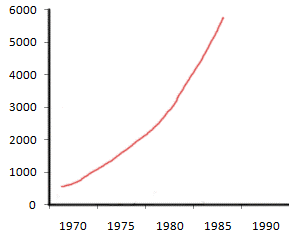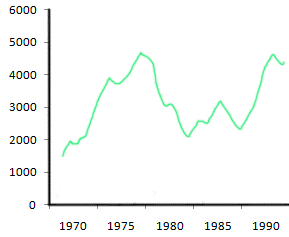|
APPENDIX 1 |
|
SUMMARIZING THE GIVEN INFORMATION (graph, table, chart or diagram) |
The general structure of an overview:
|
Introduction |
Introduce the graph (ideally 1-2 sentences). |
|
General overview |
Develop your point, giving reasons and supporting them with appropriate examples. |
|
Specific features |
Group the given data by some feature. Then describe each feature. Sum up the ideas and give your final thoughts on the problem. They should not differ from those in the introduction. |
Vocabulary to describe graphs
Types of changes
|
Nouns |
||
|
a rise (of) an increase (of) a growth (of) a peak (of) a surge (of) Example: a rise of prices |
a fall (in) a decrease (in) a decline (in) a dip (in) Example: a fall in prices |
a fluctuation (of) a variation (in) Example: a fluctuation of prices
|
|
Verbs |
||
|
to rise to increase to surge to grow to peak
|
to fall to decrease to decline to dip to dive to plunge to fluctuate to vary |
Large falls: to plummet
Large rises: to rocket to soar to leap (->leapt)
|
|
Description of changes
|
||
|
Adverbs |
Adjectives |
|
|
sharply suddenly rapidly abruptly dramatically significantly considerably markedly wildly
Example: the prices rose
sharply slightly gently gradually steadily modestly marginally Example: the prices increased modestly |
|
sharp sudden rapid abrupt dramatic steep significant considerable marked substantial spectacular
Example: there was a considerable growth
slight gentle gradual steady consistent modest marginal
|
|
Useful phrases Introducing the graph
The graph/table/pie chart/bar chart/diagram ... gives information about/on ... provides information about/on ... shows ... illustrates ... compares ... explains why ... describes ... draws the conclusion of (a survey) ... a small fraction, a small number, a small minority a large portion, a significant majority nearly a fifth, almost 10%, in region of 40%, more than a half, over a quarter, around two thirds, more or less three quarters, exactly one in ten, approximately a third
|
||
|
Linking structures |
||
|
Listing firstly, secondly, thirdly first, furthermore, finally to begin, to conclude next
Reinforcement also furthermore moreover what is more in addition besides above all as well (as) in the same way not only ... but also
Deduction then in other words in that case otherwise this implies that ... if so/not
Expressing an alternative alternatively rather on the other hand the alternative is another possibility would be
Similarity equally likewise similarly correspondingly in the same way
|
Giving examples for example for instance as follows: that is in this case namely in other words
Result/consequence so therefore as a result/consequence accordingly consequently because of this/that thus hence for this/that reason so that in that case under these circumstances
Concession (smth. unexpected) even though however however much nevertheless still yet
Stating the obvious obviously clearly naturally of course as can be expected surely after all
|
Generalising on the whole as a rule for the most part in most cases generally |
|
Highlighting in particular particularly especially mainly
Reformulation in other words rather to put it more simply
Transition to new point now, as far as x is concerned with regard/reference to as for ... it follows that turning to
Contrast instead conversely on the contrary in contrast in comparison
Summary in conclusion to conclude in brief to summarise overall therefore |
||
An example of describing a diagram

1. Introduction
The diagram explains the way in which steel rods are produced for the furniture industry.
The diagram shows the process of metal rods production for the furniture industry.
2. Overview
Overall, the process consists of eleven stages, beginning with the raw material and ending up with the product’s inspection.
3. Specific features
First of all, iron ore, yellow ore and carbon are collected to serve as a raw material for steel rods manufacturing. After that, the raw material is melted in a melting slit, where it is heated to a temperature in range of 1300-1500 °C. The melted mass is then transferred to a smelting cabin to undergo refinement. Next, the candescent metal is put in a pouring machine and poured into ingots.
In the next stage, the ingots are connected to a cooling reservoir, where the temperature falls to 60-100 °C. Metal goes through special nozzles and cools down, forming strands. Following this, the metal strands proceed to rollers that change their shape. Next, the products are put into a heating machine, where they undergo heat treatment. Subsequently, a measuring automaton completes a surface check of the products.
After that, the metal rods are sized by special cutters and get ID stamping. Finally, the products undergo inspection and are ready for use.
4. Sum up the ideas and give your final thoughts on the problem.



